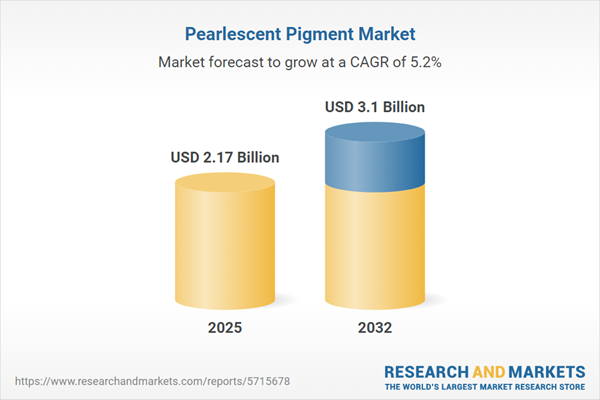Speak directly to the analyst to clarify any post sales queries you may have.
The pearlescent pigment market is gaining traction as companies increasingly pursue materials that deliver both visual distinction and technical functionality, reflecting new priorities in product innovation and regulatory requirements. Senior executives recognize the growing value of pigments that balance aesthetics, compliance, and sustainability, positioning them for competitive differentiation across diverse sectors.
Pearlescent Pigment Market Snapshot: Growth and Key Trends
The pearlescent pigment market is projected to grow from USD 2.06 billion to USD 3.10 billion between 2024 and 2032, representing a compound annual growth rate of 5.22%. This expansion is driven by broader adoption in multiple sectors, including automotive, cosmetics, plastics, textiles, printing inks, and packaging. Competitors are investing in innovations to enhance pigment durability and optical properties, responding to ongoing R&D and evolving product chemistry. Rapid product innovation and sustained competition are spurring continuous formulation improvements, influencing sourcing strategies, and shaping strategic responses to market and regulatory changes.
Scope & Segmentation: Strategic Deployment across Sectors
- Form: Powders and liquid dispersions support both water- and solvent-based systems, broadening use across industrial coatings, consumer applications, and niche product lines.
- Type: Natural mica, synthetic fluorophlogopite, synthetic pearl, and titanium dioxide-based pigments accommodate varying performance needs and deliver distinctive visual effects for brands.
- Application: Integration covers architectural, automotive, and industrial coatings. In cosmetics, pigments are used for face, eye, lip, and nail formulations. Solutions also extend to plastics, printing inks, and textile fibers, enhancing design versatility.
- End Use: Products serve original equipment manufacturing, construction (commercial and residential), packaging for consumer and pharmaceutical goods, and personal care, including haircare, skincare, and oral care.
- Regional Coverage: Analysis includes the Americas, Europe, Middle East & Africa, and Asia-Pacific, highlighting differing market requirements, compliance demands, and adoption rates driven by local consumer preferences.
- Technologies: Innovations such as advanced synthetic mica, fluorophlogopite manufacturing, low-VOC dispersions, engineered nanoparticle pigments, and digital printing integration are enabling new market approaches while supporting regulatory compliance.
- Key Companies: Major players—Merck KGaA, BASF SE, Eckart GmbH, DIC Corporation, Venator Materials PLC, Clariant AG, Ishihara Sangyo Kaisha Ltd., Sudarshan Chemical Industries Ltd., Kobo Products Inc., and Ferro Corporation—strengthen resilience throughout the global supply chain and foster sector stability.
Pearlescent Pigments: Key Takeaways for Senior Decision-Makers
- Surface engineering advancements and use of synthetic raw materials facilitate progress toward sustainability goals by improving product performance and ensuring compliance-readiness.
- Continuous regulatory updates, particularly regarding volatile organic compounds and heavy metals, underscore the importance of robust supply chain traceability and environmentally responsible sourcing choices.
- Selection of pigments aligns with dual priorities: striking visual differentiation and adherence to certification standards, helping to streamline market approval processes and foster reliable brand identity.
- Investments in digital manufacturing and advanced printing workflows deliver agility, support deep product customization, and enable organizations to respond promptly to evolving consumer and regulatory demands.
- Regional product adaptation remains essential, as consumer and regulatory requirements vary by geography, notably within Asia-Pacific and European markets, prompting targeted development and distribution initiatives.
Tariff Impact: Navigating U.S. Raw Material Cost Dynamics
Recent tariffs on key pigment inputs such as natural mica and titanium dioxide have shifted cost structures for U.S.-based manufacturers. Companies are re-evaluating supplier portfolios, emphasizing supply chain diversification and considering local processing options. Small and mid-sized enterprises are taking proactive measures to optimize sourcing and pricing, ensuring competitiveness against larger industry peers.
Methodology & Data Sources
This study blends qualitative insights and quantitative analysis, utilizing stakeholder interviews, technical literature review, patent research, regulatory framework assessment, and trade documentation evaluation. Findings are validated to reflect the actual state of the pearlescent pigment market, supporting confident decision-making.
Pearlescent Pigment Market: Why This Report Matters
- Presents executives with actionable insights for targeting high-potential segments and regions, guiding resource deployment and market expansion strategies.
- Delivers research and development teams intelligence on emerging technologies and compliance drivers, enabling tailored innovation and accelerated time-to-market.
- Empowers leaders to anticipate and address regulatory shifts and evolving market needs, strengthening strategic planning and building organizational resilience.
Conclusion
Pearlescent pigments offer measurable value through improved product differentiation and enhanced brand visibility. Companies prioritizing innovation, sustainable sourcing, and operational agility are better positioned to satisfy market and compliance expectations.
Additional Product Information:
- Purchase of this report includes 1 year online access with quarterly updates.
- This report can be updated on request. Please contact our Customer Experience team using the Ask a Question widget on our website.
Table of Contents
3. Executive Summary
4. Market Overview
7. Cumulative Impact of Artificial Intelligence 2025
List of Figures
Samples

LOADING...
Companies Mentioned
The key companies profiled in this Pearlescent Pigment market report include:- Merck KGaA
- BASF SE
- Eckart GmbH
- DIC Corporation
- Venator Materials PLC
- Clariant AG
- Ishihara Sangyo Kaisha, Ltd.
- Sudarshan Chemical Industries Ltd.
- Kobo Products, Inc.
- Ferro Corporation
Table Information
| Report Attribute | Details |
|---|---|
| No. of Pages | 186 |
| Published | October 2025 |
| Forecast Period | 2025 - 2032 |
| Estimated Market Value ( USD | $ 2.17 Billion |
| Forecasted Market Value ( USD | $ 3.1 Billion |
| Compound Annual Growth Rate | 5.2% |
| Regions Covered | Global |
| No. of Companies Mentioned | 11 |









